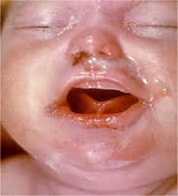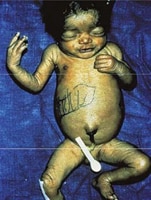Congenital Syphilis
Background
Syphilis is caused by the bacterium Treponema pallidum. The infection is most commonly transmitted through sexual contact (vaginal, oral, or anal sex). Birth defects can occur in infants born to women who are infected with syphilis prior to or during pregnancy.
Main clinical manifestations in the mother
In primary syphilis, a sore or multiple sores appear at the site where the bacterium entered the body – typically near the genitals, the rectum, or the oral cavity. The sores are usually firm, round and painless. In secondary syphilis, fever, swollen lymph nodes and skin rash, and wart-like genital lesions (condyloma lata) can be seen. In latent stage, there are no signs or symptoms. In tertiary syphilis, several medical problems affecting the heart, neurologic system and other organs can be seen. Individuals with the infection move from one stage to the next in the absence of treatment.
Main clinical manifestations in the infant
Some infants with early congenital syphilis are asymptomatic at birth. Clinical manifestations of early congenital syphilis might include rhinitis (“snuffles”), hepatosplenomegaly, skin rash with desquamation, chorioretinitis and pigmentary chorioretinopathy (salt and pepper type), glaucoma, cataracts, interstitial keratitis, optic neuritis, periostitis and cortical demineralization of metaphysis and diaphysis areas of long bones, anaemia and thrombocytopenia. Some clinical signs consistent with congenital syphilis – such as hydrops and hepatosplenomegaly – might be detected by ultrasound during pregnancy. Infants who remain undiagnosed and untreated can progress to late congenital syphilis, resulting in numerous additional clinical manifestations, including, but not limited to: saddle nose due to destruction of cartilage, frontal bossing due to periostitis, tibial thickening (saber shins), joint swelling (clutton joints), perforation of hard palate, abnormal tooth development (Hutchinson’s teeth, mulberry molars), interstitial keratitis, neurologic deafness and optic atrophy.
Infants might be born without clinical signs of syphilis but go on to develop late-stage manifestations of untreated congenital syphilis that include developmental delay, neurologic manifestations and late congenital syphilis physical signs.
Fig. 54. Clinical findings in the infant

Typical desquamating and maculopapular skin lesions; punched out, pale, blistered lesions mainly on ears and nasal bridge, and desquamation of feet and palm.
Photograph source: Dr Ronald Ballard.

Rhinitis with mucopurulent nasal discharge
Photograph source: Dr Ronald Ballard.

Hepatosplenomegaly and jaundice in an infant with congenital syphilis. Black markings on infant indicate liver margins.
Photograph source: Dr Ronald Ballard.

X-ray of bone abnormalities, syphilitic metaphysitis in an infant with diminished density in the ends of the shaft and destruction at the proximal end of the tibia (right).
Photograph source: Dr Ronald Ballard.
Relevant ICD-10 codes
A50.9 Congenital syphilis, unspecified
Q12.0 Congenital cataract
Q15.0 Congenital glaucoma
Checklist
| Checklist |
|